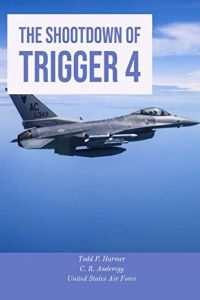- AFHF Member Authors
The Shootdown of Trigger Four
by Dick Anderegg and Todd P. Harmer
Of the many axioms that rule the swirling world of aerial combat, none is truer than “get the first shot.” Fighter pilots will go to almost any length to beat their adversaries to the draw, because that puts the opponent on the defensive. It is a very uncomfortable feeling to be defensive, when one is operating a machine that is by its nature offensive. Granted, the fighter may perform defensive missions, but even the newest fighter pilot learns that the best defense is to attack before the target knows it is under attack. More than three decades ago, fighter crews received a weapon system designed to let them throw the first punch—the AIM-7 Sparrow. The first versions of the AIM-7 seemed impressive; it was a large missile, 425 pounds, with a devastating warhead of expanding steel rods propelled outward in an expanding circle by nearly 70 pounds of explosive. Since the missile was radar-guided, the F-4 Phantom II crews could fire it under any conditions: at night, through the weather, at targets more than ten miles away. In fact, they could fire it beyond visual range without ever seeing the target. The Sparrow seemed to be an ideal weapon to fire from long range at Soviet nuclear bombers attacking America and her military forces.Then came the air war over Vietnam, and the fighter crews there soon realized that AIM-7 shots beyond visual range were often more dangerous to other Americans than to the enemy, because there was no way to identify the target as friend or foe. Air Force and Navy crews alike quickly reverted to the eyeball as the only sure way to discriminate. They abandoned the capability of the AIM-7 to reach beyond visual range, as they came to distrust shots that might lead to a fratricide—the inadvertent downing of a friendly fighter.By 1972 a new system was in place in a handful of Air Force F-4s. Nicknamed Combat Tree, the system allowed these few fighters to interrogate the beacons North Vietnamese MiGs carried to show their position to their radar controllers. If an F-4 identified a MiG with Combat Tree, and the crew was certain that no friendlies were in front of them, the crew could shoot beyond visual range. Nonetheless, it was risky for several reasons. Navy fighters entered from one direction as Air Force fighters entered from another. Groups were on different radio frequencies. Sometimes targets changed at the last minute. The weather was almost always a factor. It was common for strike packages to become confused as flights got separated. Combat leaders often had to improvise in a thick fog of war.

